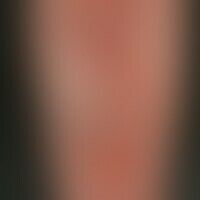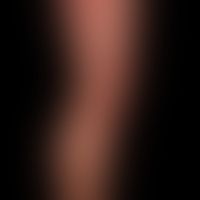Image diagnoses for "Leg/Foot"
395 results with 1158 images
Results forLeg/Foot

Hypertrophic Lichen planus L43.81
Lichen planus verrucosus: Large, coarse, brownish to brownish-red plaques with a verrucous surface that have been present for 6-7 years. There is itching, and several scratch artefacts have been found in the vicinity of the skin lesions.

Necrobiosis lipoidica L92.1
Necrobiosis lipoidica: a condition that has existed for years and is constantly worsening; no diabetes mellitus known.

Necrobiosis lipoidica L92.1
Necrobiosis lipoidica; overview of the right lower leg: Approx. 7 x 20 cm large, sharply defined, erythematous, slightly elevated plaque with distinct ulcerations along the tibial edge of a 38-year-old female patient.

Varicella B01.9
Varicella: generalized exanthema (aspects of erythema multiforme) with coexistence of larger and smaller papules, vesicles, plaques.

Tinea cruris B35.8
Tinea cruris: chronic plaque that is slightly faded in the centre and accentuated at the edges.

Lichen planus classic type L43.-
Lichen planus. chronically active, multiple, increasing, disseminated standing, partly confluent, first appearing about 6 months ago, mainly localized at the inner edge and back of the foot, 0.3-0.6 cm large, itchy, red, smooth, shiny papules in a 46-year-old woman. similar papules appeared on both inner wrist sides. Furthermore, a whitish, net-like pattern of the buccal mucosa of the mouth appeared.

Zoster B02.9
Zoster. severe zoster in a 53-year-old patient. disseminated, grouped blisters and pustules on dark red erythema on the left inner thigh above the knee. course along the segment L2.

Lymphomatoids papulose C86.6
Lymphomatoid papulosis: intermittent, painless, papules and nodules with central necrosis and crust formation (nodules above).

Scar atrophic L90.5
Scar atrophic: extensive atrophy of the skin after many years of use of systemic glucocorticoids (inhaled glucocorticoids due to bronchial asthma). the bizarre scars developed after banal blunt trauma "the skin was torn like a cloth".

Leg ulcer L97.x0
Ulcer cruris: Painful ulcer extending to the muscle fascia, with sharp edges and painful ulcer in necrobiosis lipoidica; bizarre vascular ectasia due to the atrophying underlying disease.

Necrobiosis lipoidica L92.1
Necrobiosis lipoidica: Sharply defined, centrally atrophic plaque, distinct brown-red tinged edges, in the cnetrum of the lesion translucent underlying venous convolutes.

Purpura pigmentosa progressive L81.7
Purpura pigmentosa progressiva. incident light microscopy, blurred, yellow-brownish spots (star), in addition to punctiform, fresh bleeding (horizontal arrow) also older brown-reddish spots already in decomposition (vertical arrow). line pattern: traced skin line pattern of the skin of the lower leg

Vascular malformations Q28.88
Malformations, syndromal vascular: Nevus flammeus (capillary malformation, no arterio-venous anastomoses) with soft tissue atrophy and pelvic obliquity, no pain symptoms.

Atopic dermatitis in children and adolescents L20.8
Eczema atopic in child/adolescent: 14-year-old girl. acute episode of the previously known atopic eczema.

Necrobiosis lipoidica L92.1
Necrobiosis lipoidica: irregularly configured, sharply defined, plate-like, atrophic, "scleroderma-like", smooth plaques. brownish-yellow sunken centre with atrophy of skin and fatty tissue. reddish-violet to brownish-red rim.

Fasciitis necrotizing M72.6
Fasciitis, necrotizing. foot of a 53-year-old patient. after a banal traumatic injury to the inner ankle, a fulminant, highly painful, doughy swelling developed within 3 days with diffuse redness of the entire lower leg. extensive necrosis of the skin of the inner ankle and over the edge of the tibia. fluctuating swelling in the middle of the lower leg. here incision with evacuation of about 50 ml of purulent secretion.








